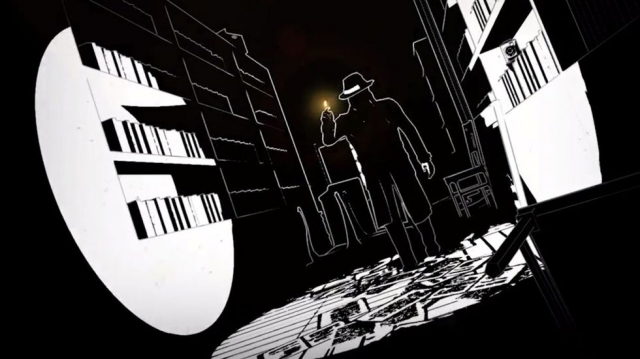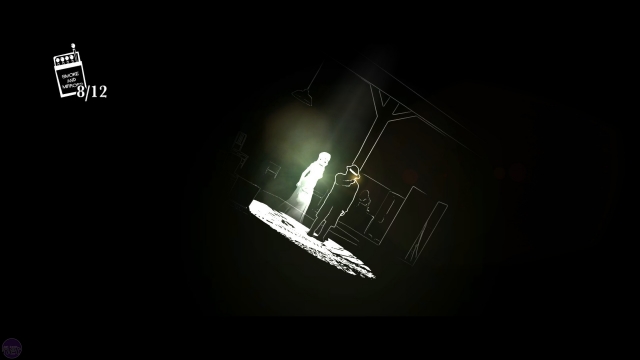
White Night Review
We don’t usually think about the implications that videogame titles have. White Night’s title stands for exactly what the game conveys, including the most complex and esoteric connotations: a restless and sleepless night, where ghosts of the past and present come back to haunt you; a space of time where your imagination takes over you and your deepest and darkest fantasies materialize before you; the struggle of maintaining your sanity, fighting against whatever thoughts may cloud your judgement of other people, and over all, yourself. There are demons that one must resist, but the hardest part is the realisation of their existence, leaving you vulnerable and frightened, leaving you on your knees.
In this case, the American Great Depression was a root of all uncertainties and tragedies. People struggled to get by, jazz and soul music cried laments of pain and desolation, alcohol consumed many and others were taken by insanity or desperation. White Night’s black-and-white noir atmosphere, inspired by German expressionism, tries to represent this troubled environment depleted by the darkness in everybody’s hearts and future. Among all devastation, there is always hope, a light at the end of the road. Darkness and light, black and white, opposite sides of the same coin, have clear metaphorical meanings regarding people’s lives, and you’ll never understand it better than in White Night.
White Night follows, mechanically, a long tradition of adventure survival horror videogames, third-person view videogames with static and fixed-camera angles, just like 1992’s Alone In The Dark, or the first Resident Evils. We can witness the transposition of the main mechanical cornerstones from the early games in the Resident Evil series, where a shoulder camera has taken over the series, forcing the player into combat engagement and away from the enemy avoidance-focused gameplay prioritised in the first three games. Much like in any of these games, the fixed camera won’t let you control your view, leaving many parts of the room hidden from you, and with it, the threats that may hide in them. The fixed-camera view makes you always have the feeling of being part of some demented game, as though you were being watched over, like your presence was unwanted, however urgent it may be. And again, like in any of these games, the mansion becomes a hostile environment, with very few safe havens, where you’re locked in with one option left: push forward.

White Night seizes these concepts and pushes them, leaving the player defenceless against ghosts that are literally impossible to beat in combat. After all, they are matter-less ghosts. In fact, this game does not even provide you with weapons or possibility of attacks, minimising the tactical possibilities to one: fleeing and circumventing enemies. The number of buttons you’ll need is limited to four (interact, journal, run and light up a match), plus the joystick to move and another one to pause the game, because in reality, you can’t physically fight that which is tormenting you. You can’t jump, crouch or roll; however, the game forces you to focus on movement to engage with enemies, which you won’t be able to kill — only a few of them — but only avoid. Ironically, this movement-focused gameplay encourages you to take a very slow and methodical approach to enemies. Most of them won’t move, waiting for you to get close enough to attack you. Some others roam patrolling corridors, giving you a time frame for you to move. You need to be aware of where enemies are, knowing when to move, when not to move and when to run, as running will make ghosts more susceptible to be set off. Your movements are slow and you sway and trip when you run. If we add the sometimes awful camera angle — over twenty years of fixed cameras and this is the best you can do positioning them? — that won’t let you see where you are or what’s around you, manoeuvring around a room being chased after is something you’ll want to avoid — as much as the game sometimes forces you to do.
As in many horror games lately, the use and management of light and darkness is imperative. In White Night, these polar opposites are reinforced by the black-and-white design. Light allows for the existence of white, which allows for the existence of contrasts, demarcating the silhouettes of every object in the house — however unclear some may be. Every puzzle that there is to be solved gravitates around the need of light: you can’t interact with anything that is not lit, which makes you praise those sources of lights, making sure they work properly. These lamps and candles are actually very scarce, most of them being very unreliable, so you’ll need to trust the very few matches that you have. You will soon discover that although matches are not scarce, as they’re spread all around the house, the maximum amount of them you can carry is quite limited (twelve). Yes, our character is quite useless in this way, but this limitation gives room for a very needed and tense resource management system, as the main supplies of matches are in places well-guarded by ghosts. Matches are not that reliable either, as they go out quite quickly when you run, which is usually when you’re being chased by ghosts, and more often than not they won’t light up when you need them to, just like in real life.
Now, let’s talk about the narrative and exposition — because what a story! Granted that the player-controlled character will have a few redundant monologues where you’ll be looking at a dry and tedious black screen, plus the division of the game in chapters doesn’t provide anything, the rest of the exposition is absolutely fantastic. The main story, presented in the cutscenes and dialogues, is one of love. Our nameless protagonist enters a mansion in pursuit of help to deal with his injuries after a car accident — this is why the movement is handicapped in the rest of the game — only to find the ghost of a girl, Selena. Selena captivates and enamours both the player and the controlled character with her voice and excruciated cry for help, and is the only friendly ghost in the mansion, the only light in the dark night, a guide and companion throughout our mansion incursion. The mansion is owned by the Vesper family, currently the only member left alive is William, whom Selena had a platonic romance with. She was in life a Norwegian soul singer, whose family moved to the States only to find desolation and poverty. The most complex and deepest parts of the plot are discovered through diaries, letters and notes, scattered throughout the house. They were written by Selena, William or either of William’s parents Margaret (born Venter-Cross) and Henry Vesper. They talk about suffering during the Great Depression and murder, about what the ghosts in the house are, about family and personal disputes of the members of the family, about William’s demons and yearnings, about his alchemical quest and his obsession with femininity, about how both Selena and William found comfort and a connection over jazz and soul, as a singer and a pianist respectively.

Scary games sometimes make you stop playing, snuggle under the bed covers and cry for a bit, no matter how engaging the mechanics may be. They will sometimes make you pee yourself a little and take the game in little doses. These writings, very emotionally, personally and beautifully written, became the reason I wanted to push through the fear, diaper up and keep playing. You won’t find them in order, so it becomes a puzzle to make sense of them. They give you inputs to the story, different looks and stories that enhance the experience of being within the walls that contained all this drama. They will help you make sense of the story and comprehend the motives and illusions of all the characters, however badly-explored some very few elements may be. I’m holding myself to not spoil the story, as the ending will make the mechanics absolutely fitting for the narrative.
White Night ends up being a recollection of ‘90s fixed camera mechanics, with a new refreshed artistic twist on the plot and graphics, enhancing the artistic expressivity of the piece. White Night stands as one of the best executed and most emotional games in the past few years, with outstanding game-character-player relation and a disturbing and frightening setting. I’d recommend you to toughen up — yes, you wuss… — and play this game in the dark, letting the game’s atmosphere and suggestibility devour you.
White Night (Reviewed on Windows)
Excellent. Look out for this one.
White Night stands as one of the best executed and most emotional games in the past few years, with outstanding game-character-player relation and a disturbing and frightening setting










COMMENTS